This post may contain affiliate links meaning if you buy from them, I will make a few pennies, at no cost to you. See disclosure here.
Kitchen conversions – the bane of most home chefs’ existence. This post will give you common cooking and baking conversions to reference the next time you’re modifying a recipe. Also included, a handy printable to hang in your kitchen!
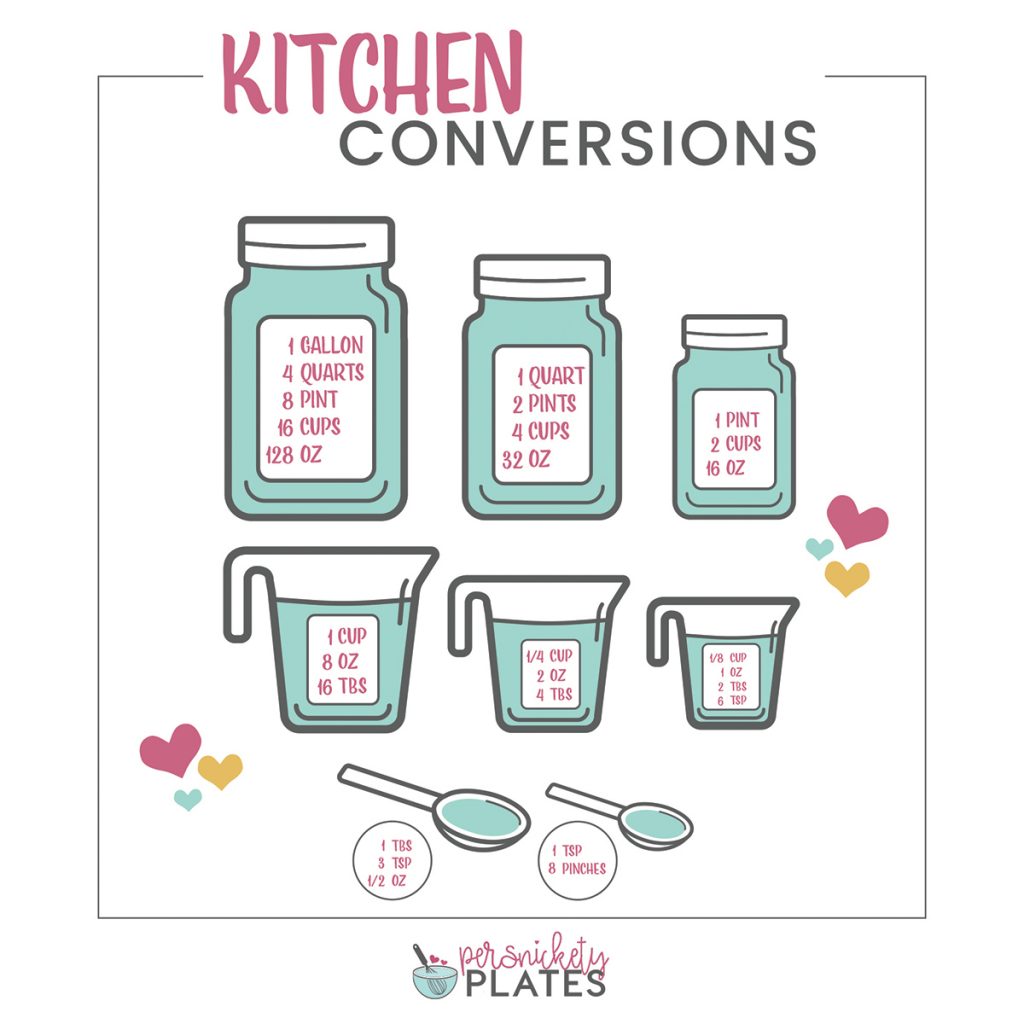
Click HERE to save to Pinterest
No one likes being in the middle of a brand new recipe, scouring the cabinets for a measuring cup or spoon while their temperamental hollandaise sauce is ruining with every passing second!
What ends up happening? They find every single measuring devices they own – except the one they need and their sauce ends up in the trash a scrambled egg disaster! Oh, the horror!
No, seriously – the horror!
We’ve all been in a situation like the above before, but instead of getting frazzled why not just convert!
When it comes to baking and measurements, every tablespoon, ounce, and cup is accounted for, and conversions must be precise. If you don’t want to lose your mind (or the integrity of a new recipe), then bookmark and pin this kitchen conversion guide as soon as possible! (Like Now – but then continue reading!)

There are so many different measurements that you need to know, and it is easy to get confused or make mistakes because of these conversions.
For example, how much does 1 cup equal in ounces? What about tablespoons and teaspoons?
This blog post will teach you all the common cooking/kitchen conversion measurements such as gallons to ounces, tablespoon to a teaspoon, and cup to ounces.
I’ll also talk about tools that can help with measuring, such as scales for weighing out larger quantities of food or spoons/cups for smaller measurements.
We’ll also discuss what to use when you don’t have measuring tools and some common baking pan conversions.
Finally, we’ll mention abbreviations, so you know what they stand for when reading recipes online or in cookbooks!
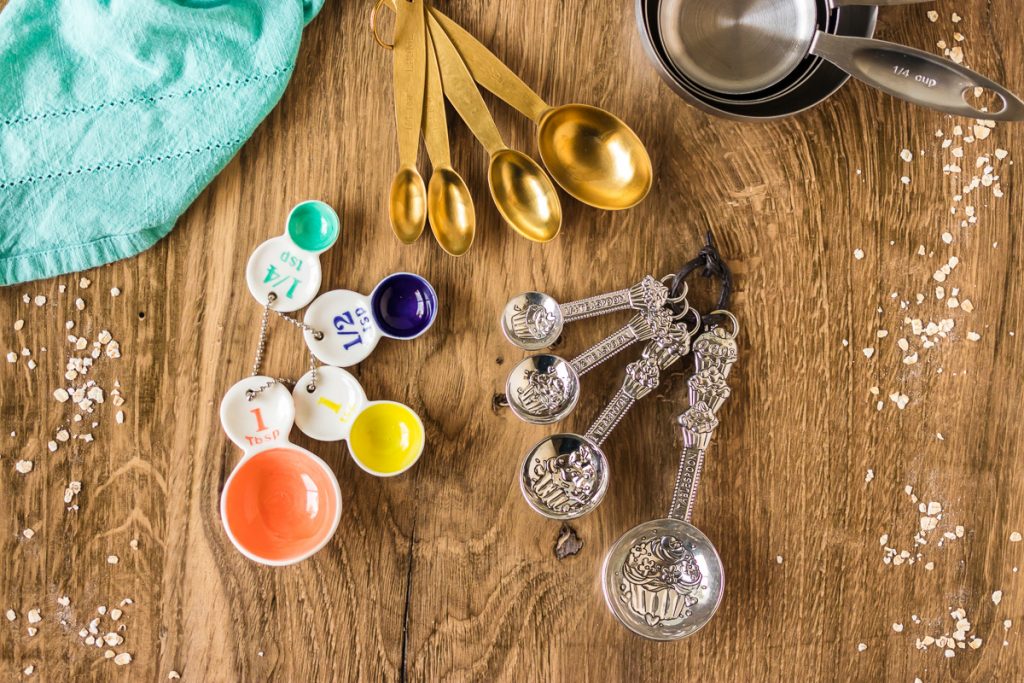
Kitchen Measurement Tools
The most common kitchen tools used for measuring ingredients are food scales, measuring cups, and spoons.
Food scales are great for weighing your ingredients, which is really the best way to go, though most people don’t because it’s a bit more work.
Measuring cups are the easiest way to measure out smaller amounts of liquid or dry goods, like flour and sugar.
Kitchen measuring tools will include both standard American measurements (ounces) along with metric units for those who live outside of the US. You can use any type you’d like, but it’s best to pick one that is heat-resistant so you can use them for more than just food measurements.
Measuring spoons are an easy way of measuring out solid & liquid ingredients in minute amounts.
Standard measuring spoon sets will come in with teaspoons (tsp), tablespoons (tbsp), ounces (oz or fl oz), and even cups. If you don’t have a set or want to supplement your current collection, it’s easy and relatively affordable to buy additional spoons in the measurements that you need!
When reading recipes online or in cookbooks, be sure to pay attention to how they list their measuring units – especially when converting from one type of measurement into another!
Many recipes will commonly list measurements in cups, ounces (oz), and tablespoons. Ounces are typically used for smaller measurements, while larger quantities of ingredients use cups. Be sure to note which measurement each unit is, so you don’t get confused when reading a recipe online or following one from a cookbook.
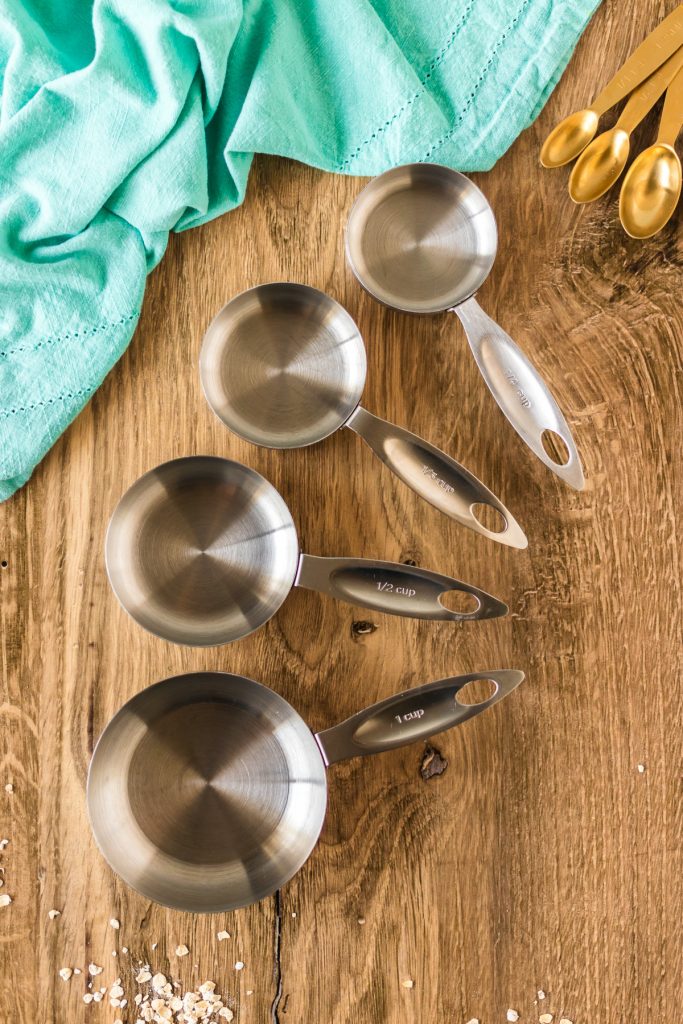
Some of my favorite kitchen tools found on Amazon
- Magnetic measuring spoons – I love that these stack so they’re not all over the drawer.
- Measuring cups – I have a slight measuring cup obsession & buy too many. Same with spatulas.
- Liquid measuring cups – shows cups, ml, & oz
Common Cooking Measurements Abbreviations
Adhering to abbreviations is also essential when following a recipe.
These cooking/kitchen conversion measurements can be confusing, so it’s best to have an idea of the abbreviations that you may come across!
For example:
- tsp – teaspoon (also sometimes shown as lower case t.)
- tbsp – tablespoon (sometimes also shown as just a capital T or TB).
- c – this abbreviation stands for cup
- oz – ounce
- fl oz- fluid ounces (abbreviation for measuring out liquids)
- ml or mL- this abbreviation will stand for milliliters, which is a metric measurement unit equal to one-thousandth of a liter. Also used when measuring out smaller amounts of liquid.
- g- grams, another metric unit for measuring out smaller quantities of solid ingredients.
- kg- kilograms
- qt – this abbreviation will stand for quart
- pt- this abbreviation will stand for a pint
- l- represents “liter,” which is a metric measurement unit equal to one thousand milliliters
- gal- this abbreviation stands for gallons
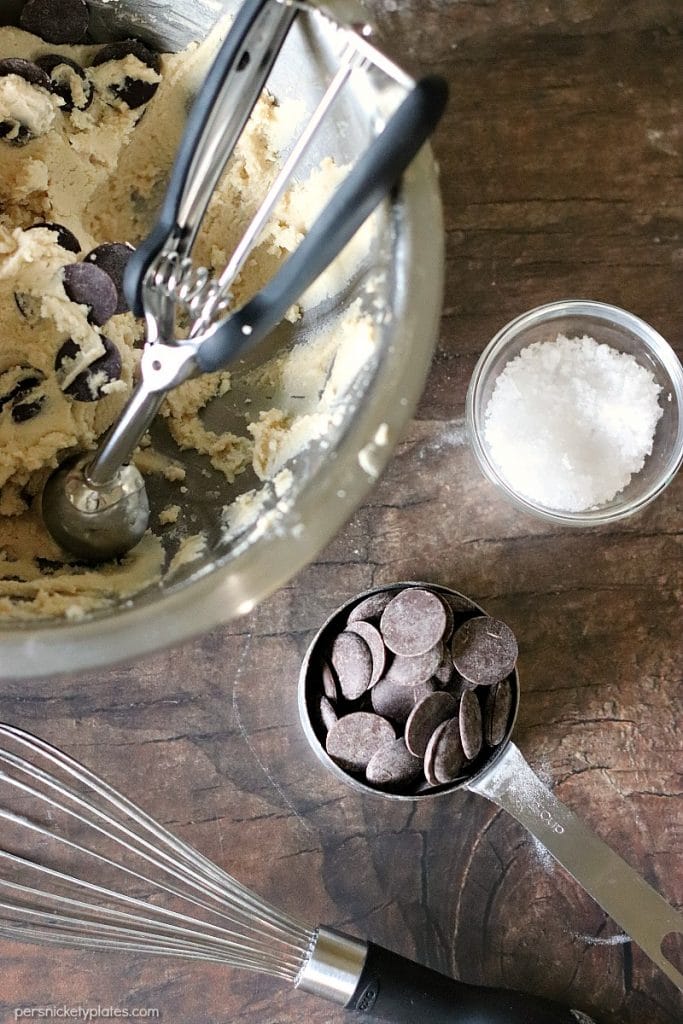
Cooking and Baking Measurements & Cooking Conversions
Alright! Let’s get into some of the most common cooking/baking measurements and conversions that you’ll need to know when making food in the kitchen!
Gallon conversions
- How many liters in a gallon? – 3.785 liters
- How many quarts in a gallon? 4 quarts
- How many pints in a gallon? 8 pints
- How many cups in a gallon? 16 cups
- How many ounces in a gallon? – 128 fluid ounces
Quart conversions
- How many pints in a quart? – 2 pints
- How many cups in a quart? – 4 cups
- How many ounces in a quart? – 32 ounces
- How many milliliters in a quart? – 950 ml
Pint conversions
- How many cups in a pint? – 2 cups
- How many ounces in a pint? – 16 ounces
- How many milliliters in a pint? – 480 ml
Cup conversions
- How many ounces in a cup? – 8 ounces
- How many tablespoons in a cup? – 16 tbsp
- How many milliliters are in a cup? – 240 ml
1/4 Of A Cup Conversions
- How many ounces in 1/4 cup? – 2 ounces
- How many tablespoons in 1/4 cup? – 4tbsp
- How many milliliters in 1/4 cup? – 59.147 ml
1/8 Of A Cup Conversions
- How many ounces in 1/8 cup? – 1 ounce
- How many tablespoons in 1/8 cup? – 2 tbsp
- How many teaspoons in 1/8 cup? – 6 tsp
- How many milliliters in 1/8 cup? – 29.573 ml
Tablespoon Conversions
- How many teaspoons are in a tablespoon? – 3 tsp
- How many ounces in a tablespoon? – 1/2 ounce
- How many milliliters in a tablespoon? – 15 ml
Teaspoon Conversions
- How many pinches are in one teaspoon? – 8 pinches
- How many milliliters in a teaspoon? – 4.928 ml
Other Kitchen Measurement Conversions
- A Dash = 1/16 teaspoon
- A Pinch = 1/8 teaspoon

How can I measure ingredients without a measuring cup?
When it comes to baking, it is essential to make sure you are properly measuring ingredients. If your recipe calls for “a cup of flour,” it is especially important to measure correctly so the flour doesn’t get packed into the measuring cup.
When baking, the most basic equipment you need is measuring cups and spoons. Luckily they are both affordable and you can even find them at a thrift store. However, when you don’t have either of these available, here’s what you can use as a substitute:
- measuring cup = standard coffee mug (about 8 oz)
- measuring tablespoon = dinner spoon
- measuring teaspoon = coffee spoon
I don’t recommend messing with the measurements or ingredients when it comes to baked goods. That’s how I end up with “why didn’t my recipe turn out??” comments lol
Some people just “eyeball” it when measuring ingredients. That means they’ll guess on the measurements and hope for the best!
Cooking gives you more leeway but baking is a science and measurements need to be followed to ensure the result you’re after.
Adjusting is fine for the experienced, but if you’re just starting out, this may lead to a few disasters. There is really no safe way to measure ingredients without some sort of tool or measuring cup.
If you’re just stocking your kitchen with gadgets and tools, make sure measuring cups and spoons are on your must-have list.
Baking Pan Conversions
I’m often asked about converting cake, brownie, or muffin recipes to different sizes. Maybe you don’t have the size the recipe calls for or maybe you just want to make less/more.
By knowing how much cake batter goes into each cake pan, you can change up the recipe to fit in another type of baking pan. (The cups refer to how much batter fits into the pan)
Below are some common conversions that should help you out.
- 9 inch round cake pan = 12 cups of batter
- 9×5 loaf pan = 8 cups of batter
- 9 inch square pan= 8 cups of batter
- 10 inch tube pan= 16 cups
- 10 inch bundt cake pan= 12 cups

Measurement Conversions Are Pretty Straight Forward But Not Always Easy To Remember
The nice thing about cooking conversions is that they are pretty straightforward, they are NEVER going to change on you, and you’ve got this handy-dandy blog post to help you in a pinch!
If you’re feeling overwhelmed, just keep in mind most of these measurements will be in weight or volume, so if you can do the math, it’s not too bad!
If you can’t do math (don’t feel bad, it’s not my strong suit either lol), then printing out a measurement cheat sheet is super helpful. Tape it to the inside of a cupboard door or put it in your junk drawer for emergencies!
If you’re going to be baking, I also recommend picking up a food scale. They are pretty cheap and will help you get the most accurate measurements possible when making baked goods.
Also, remember if all else fails, Google is your best friend here! Type “how many milliliters in a cup,” and Google will bring up the answer for you!
I hope this helps with some of your cooking measurements and conversions. Leave a comment below and let me know!
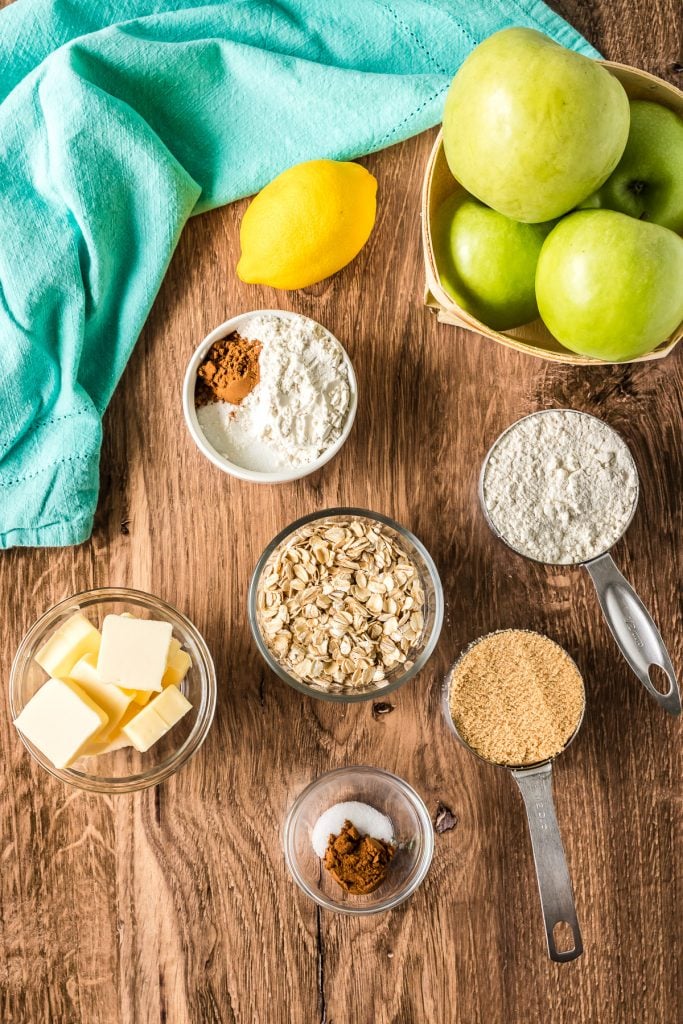
CONNECT WITH PERSNICKETY PLATES!
Follow along on my social media so you never miss a post!
Facebook | Twitter | Pinterest | Instagram
I made a fun group on Facebook for sharing recipes, asking questions, and talking about food. I’d love to have you! Request to join HERE.
Also, sign up to receive an email in your inbox for each new recipe:
FREE EMAIL SUBSCRIPTION & EBOOK
If you MAKE & LOVE this recipe, share it on Instagram and tag me @melissa_pplates and/or #persnicketyplates so I can see it. I LOVE seeing what you make & I’ll share it in my stories!
It is VERY HELPFUL to me and other readers if you leave a review after you make my recipe. Please come back & let me know how it turned out!
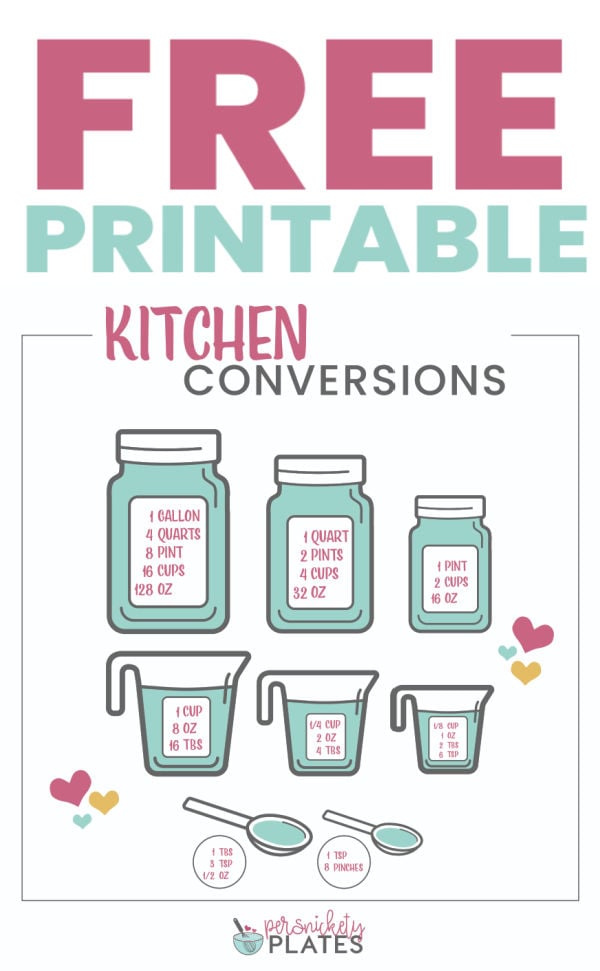
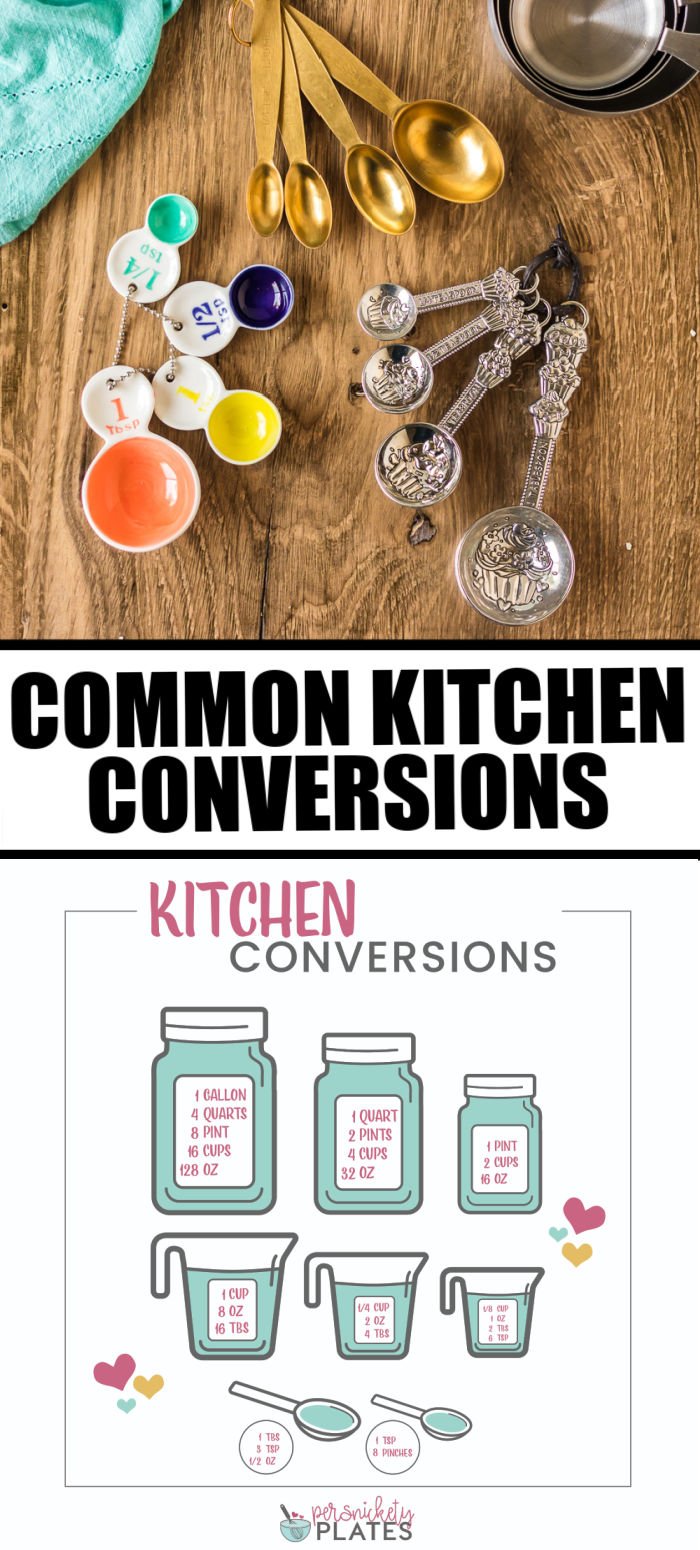
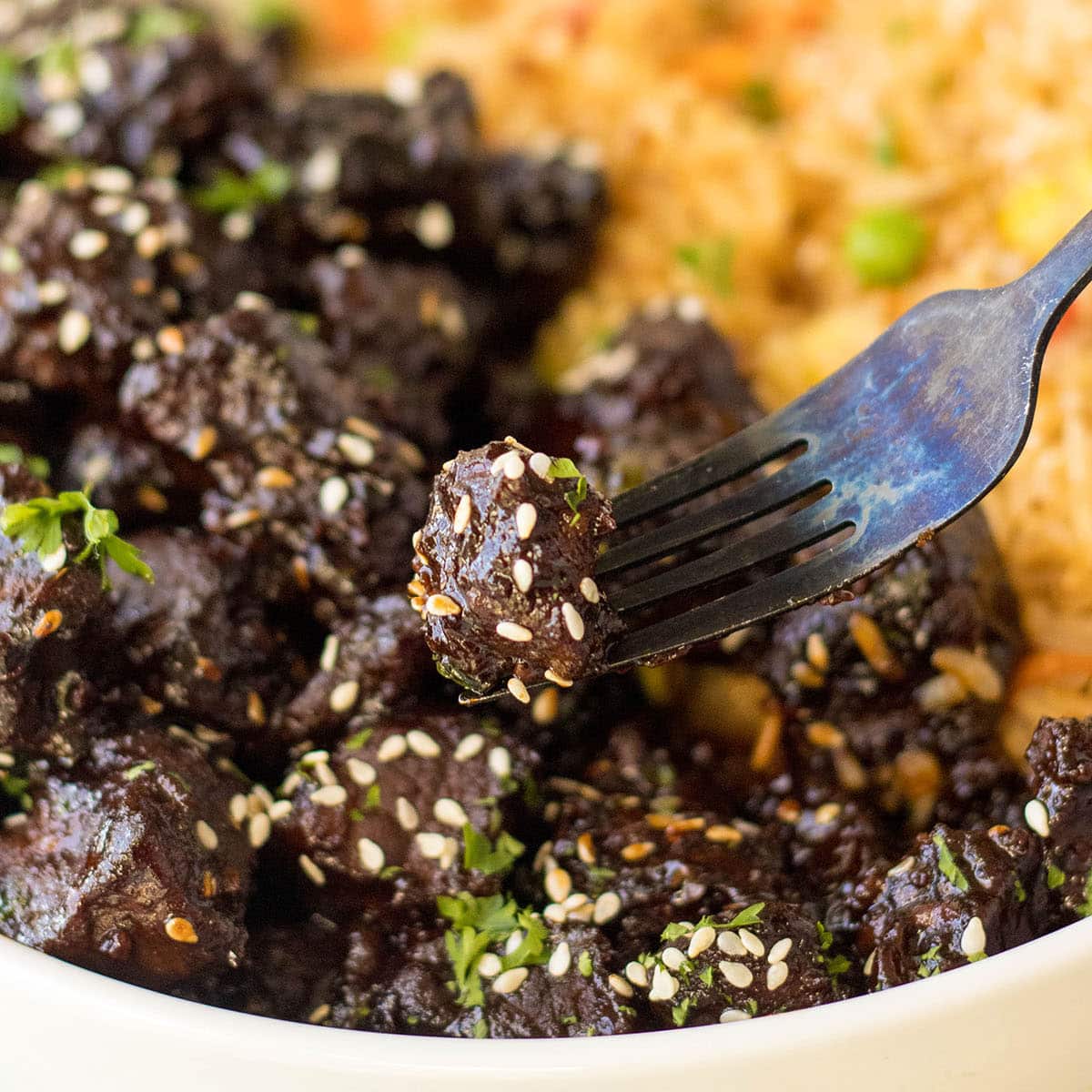
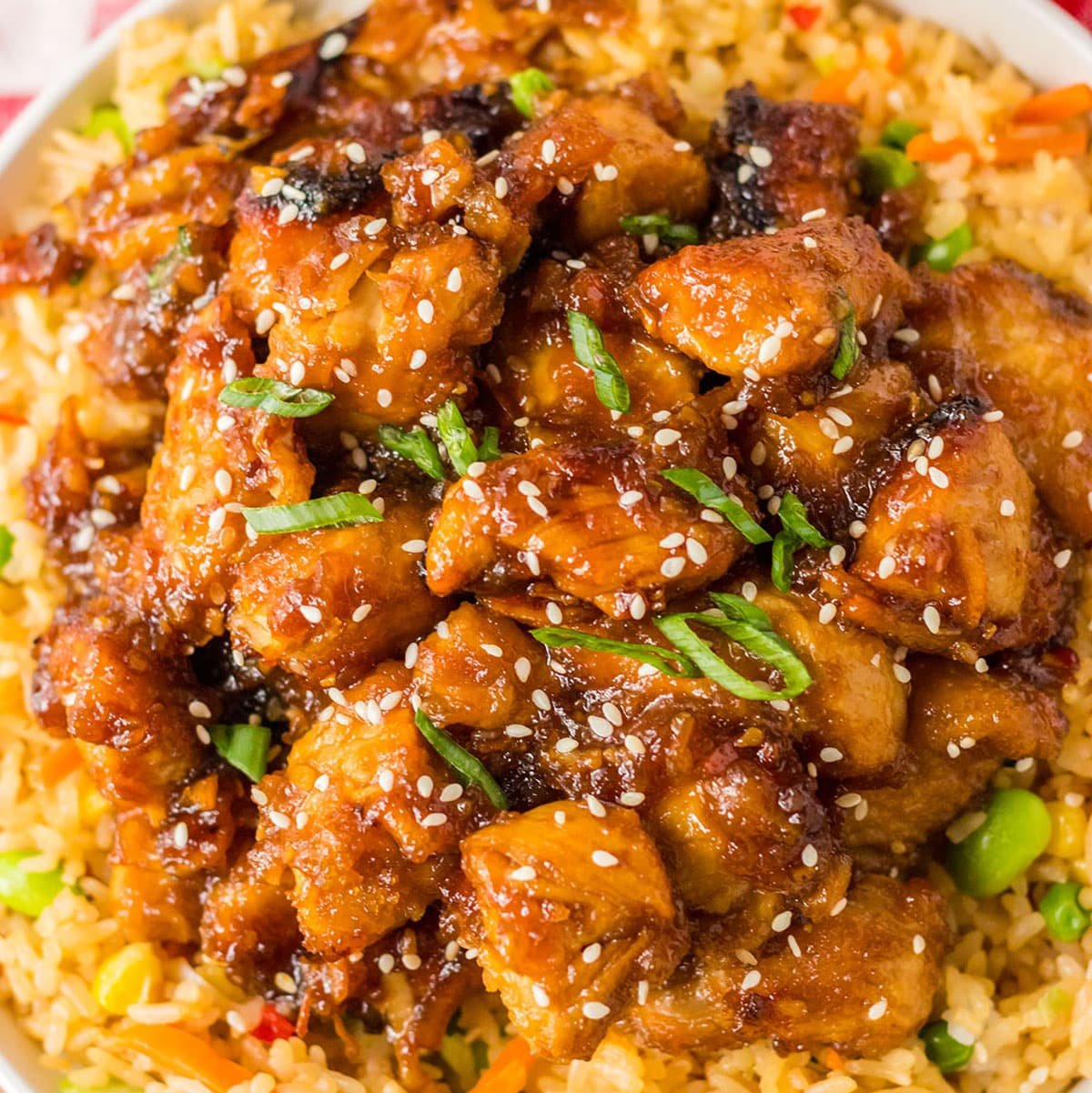
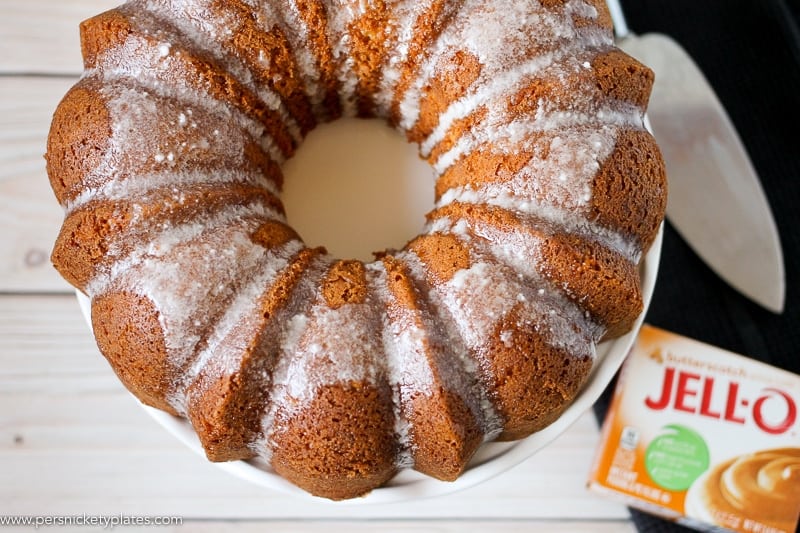
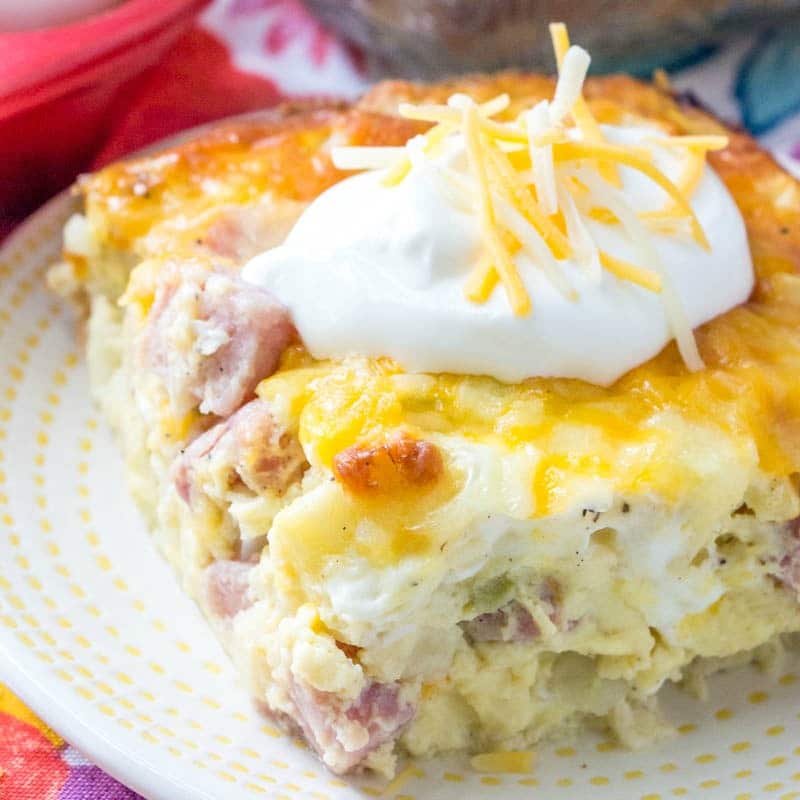
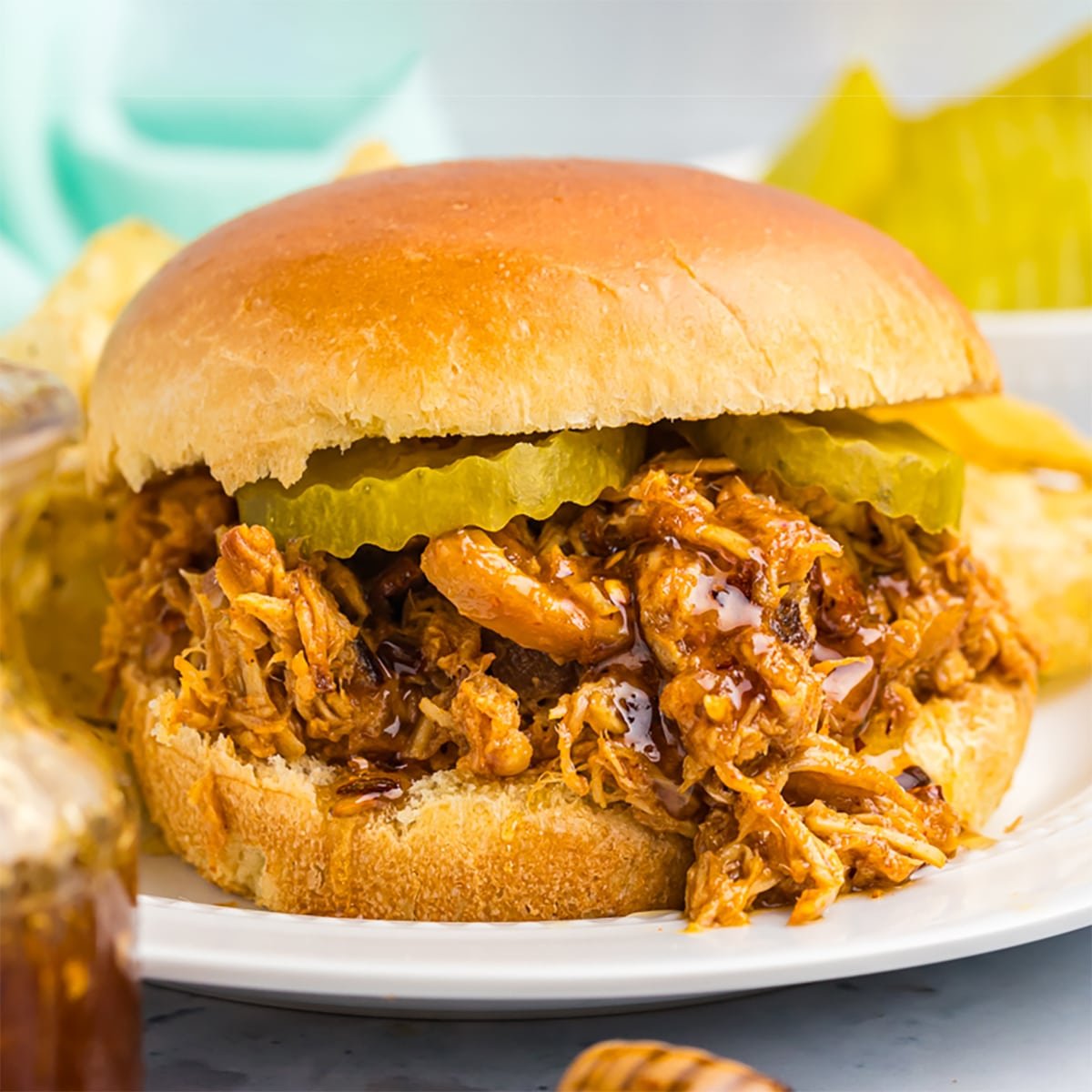


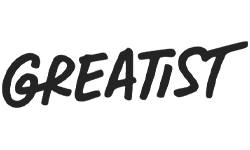
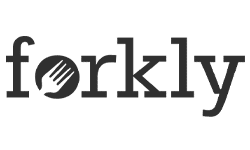
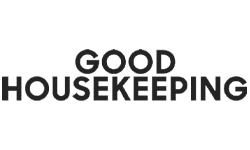




could not download the other charts – only the first one kept coming up
Hi. There’s only one..not sure which other you’re after?